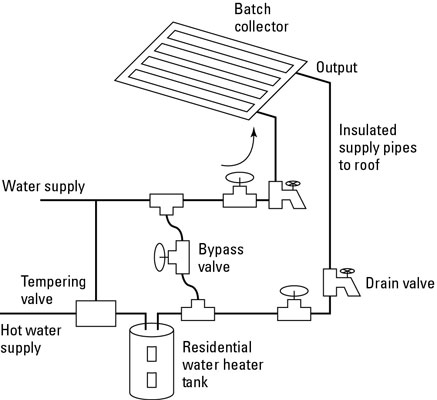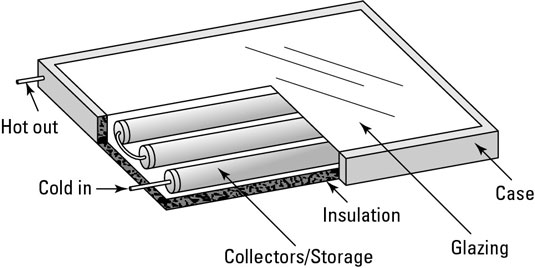An integral collector system (ICS) batch system lets you use solar energy to supplement your water heater. If you live in a mild climate, you can install a simple ICS system because you don't have to worry about freezing conditions and super hot conditions. Even if these conditions are rare, you can still install an ICS if you take a few precautions.

Over the course of a sunny day, the water in the collector heats up from solar radiation. Due to the insulation, heat doesn't exit the system anywhere nearly as quickly as it enters. Because of the thermosiphon effect, hotter water migrates to the upper copper tube (even when no water flows, the heat will flow) so that the water that ultimately flows down into your water heater tank (when a faucet is opened in the house) is the hottest water from the collector.
Whenever somebody opens a hot water tap in your house, that much water is pumped through the collector, into your domestic hot water tank.
Collectors heat the water directly, so they're a significant part of ICS.

The large-diameter, black-finished copper tubes beneath the glazed cover (and insulated from the frame) are connected in series so that water flows from the bottom to the top (such collectors are mounted at an angle). Each of the copper tubes can typically hold 10 gallons of water.
A 3 ft. x 8 ft. unit holds 30 gallons of water and collects about 22,000 BTUs for an average North American day. Cost is around $1,500 for the collector, about $2,200 if you add in the cost for pipes, installation hardware, and labor for installation. Larger units are also available.
Complete kits include all the valves, plus the collector and its associated mounting hardware. If you choose to do it yourself, give some serious consideration to how you'll lift the collector (even empty, they weigh a lot) wherever you plan on mounting it. The collector can weigh upward of 500 pounds when full of water. Make sure that your roof can take this weight.
If you mount heavy collectors close to the edge of your roof, the rafter load will be easier to handle because the load will be directly over a load-bearing wall. And if you mount one of these collectors right near your water heater, you can use as little as 8 feet of tubing to complete the system.
Here are some considerations to keep in mind concerning the valves:
Draining the system: Valves drain the water when freezing is a possibility for more than a day or so. Note the bypass valves, which allow water to bypass the solar collector and revert to normal, hot water tank operation. The valves may be controlled either automatically or manually.
Heat is a problem as well. These collectors can burst if the water gets too hot, so drain the system when experiencing extremely hot, sunny conditions.
Locating the drain valves: Make sure to locate the drain valves where children won't open them and get scalded. For safe drainage, place the drain valves outside; they may look exactly like a hose faucet.
Controlling water temperature with a tempering valve: The tempering valve is critical. It mixes cold water with the heated water from the collector when the collector water exceeds a certain temperature. This prevents scalding water from entering your household plumbing system. Always use a tempering valve in your system and never buy a cheap one.

